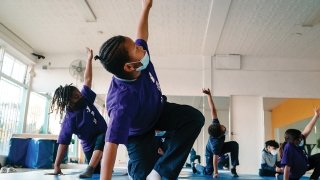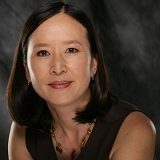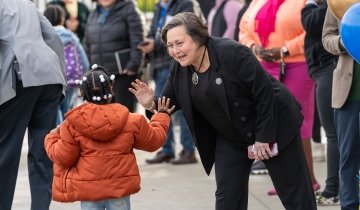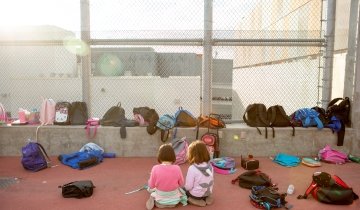Everyone holds their breath as Autumn places another weight on the Lego bridge she built with partner Paula. As the two girls, 3rd and 4th graders at Crete Academy school in the South Los Angeles neighborhood of Crenshaw, continue to add weights to their sturdy bridge, one of their competitors steps away to go “fortify my bridge.”
The kids are part of the after-school program at the Crenshaw Family YMCA. They come Monday through Friday and get out their post-class energy in the gym before settling down for homework time, tutoring and a variety of STEM activities. This day marked the end of the group’s bridge-making challenge as they put their creations to work, testing how much weight each of their structures could hold. The task was created by after-school coordinator William Chavez, who gave the kids, working in teams, height, width and clearance specifications for their bridges.
“They are like a family,” Veda Ramsay-Stamps MPA ’18, a doctoral candidate in USC Rossier’s Global EdD program and executive director of the Crenshaw Family Y, says of the kids who attend the after-school program. They come together daily not only to receive extra academic support but also to connect with one another and their community through a variety of activities, from chess and robotics to basketball and yoga. Ramsay-Stamps, who has a background in policy work, took the position at the Crenshaw Family Y in 2019, shortly before the COVID-19 pandemic turned life upside down.
Finding her way back to the heart of the city
Ramsay-Stamps was born in L.A. but grew up in New Orleans. Pontchartrain Park, a suburban-style neighborhood developed specifically for Black families after World War II during the Jim Crow era of racial segregation, was home. Famous musicians, as well as prominent Black politicians, emerged from the neighborhood. Although the house she grew up in no longer exists—the area was hit hard by Hurricane Katrina—when Ramsay-Stamps thinks of home and community, she thinks of Pontchartrain Park.
As Ramsay-Stamps was growing up, her family struggled financially. “My mother and I were extremely poor. My mother suffered from mental health challenges, so she leaned heavily on my grandparents to help raise me. She had eight brothers and sisters, who were also actively engaged in the process of helping me thrive. Even though she and I had some difficult moments, my memories in New Orleans are filled with a lot of love.”
While she spent the majority of her childhood in New Orleans, her schooling was interrupted, as she and her mother relocated to Los Angeles for short stints. Life in L.A. was challenging for Ramsay-Stamps and her mother, as they did not have the same support system they had in New Orleans.
Despite the obstacles, Ramsay-Stamps looks back on her early life in New Orleans fondly. “New Orleans definitely shaped me more in my formative years. It was a beautiful environment, filled with community love and discipline. If you did something wrong you could expect a neighbor to swiftly correct your behavior,” Ramsay-Stamps says. And it’s this type of community—where child rearing is a collective effort—that Ramsay-Stamps is trying to emulate at the Crenshaw Family Y.
When Ramsay-Stamps was a high school senior and considering next steps, her guidance counselor, who was White, said college wasn’t an option, given her grades. “I had horrible grades,” Ramsay-Stamps says. “I was very inquisitive as a child [and] always read … but no one in my household would say, ‘hey, get your homework done.’”
Her guidance counselor suggested she pursue secretarial work, but when a representative from California State University, Fresno, came to a college fair at her school, Ramsay-Stamps’ trajectory changed course. “It was as if a light bulb went off,” she says. He encouraged Ramsay-Stamps to apply to the college’s Educational Opportunity Program, an initiative designed to help low-income, historically underserved students access higher education. The program also offered a summer bridge program that would help Ramsay-Stamps prepare For the challenges of college.
So off Ramsay-Stamps went, back to California and a new home where she lived with her aunt and uncle—who later became her second parents. Given the opportunity and surrounded by people who believed she could succeed, Ramsay-Stamps excelled. Fresno State “had really good Black and Latino faculty and staff who looked out for students like me,” Ramsay-Stamps says. She also became friends with other students in similar circumstances. The support network lifted her and others up. “We were all thriving,” she says. Ramsay-Stamps was a student-body senator and graduated with her bachelor’s in sociology.
Ramsay-Stamps balanced her college studies with the challenges and responsibilities of being a new mom. She and her husband, Darrell Stamps, raised their first child when the two were students at Fresno State.
After graduation, the family moved to Washington, D.C., where Ramsay-Stamps worked as a speechwriter and legislative aide for Harold Ford Jr., the former congressman from Tennessee. There, she was introduced to policy “with a big P.”
She loved the experience: “It was mind-blowing to see the level at which young people are actually running the country. It was exciting and exhilarating to see things moving super fast, in terms of the way we were developing public policy, but the end result, as we know, is very slow [and it] takes a couple of years [for an] actual bill to pass.”
Ramsay-Stamps considered running for office after working on Capitol Hill, but she and her family decided to return to Fresno, where she began working in local government. She wanted to be engaged in public policymaking, but her time in D.C. showed her that the ones working behind the scenes were often making the wheels of government turn. She worked as an executive policy and budget analyst for the city of Fresno, where she acquired an intimate understanding of housing and economic development and how federal funds “play themselves out on the ground.” She then moved on to a company that provided tax recovery and enhancement work for government agencies.
As she gained experience and contacts, she decided to launch her own business, The Ramsay Group, a global consulting firm that assists public and nonprofit organizations with urban planning and development services.
When the 2008 financial crisis struck, Ramsay-Stamps and her family were hit hard. Many of their clients—small and medium-sized cities and nonprofits—were in financial peril. The family decided to sell everything and move to the L.A. area. They had existing clients in the area and decided the region was where they wanted to successfully “reboot the business,” Ramsay-Stamps says. They settled in the city of Santa Clarita in northern L.A. County.
Soon after, Ramsay-Stamps found her mind returning To academics. “I wanted to branch out, do something a little more hands on and connected to challenges facing communities of color in L.A.,” she says. This desire to grow her network and break out of consulting led her to the USC Sol Price School of Public Policy, where she completed her master’s. With her years of policy work and experience working at the national and local level, Ramsay-Stamps entered the master's program confidently. But she soon realized her math skills needed boosting. Her early years when she experienced interruptions in her education, left her without a strong foundation in math. She had no problem leaning on Excel and calculators when operating her business, but at USC, her economics and finance professor was asking her to work out equations “from scratch,” she says.
It was a challenge, but one she rose to. She sought tutoring and soon was able to create a foundation in math that she wasn’t given an opportunity to build as a child. Soon after graduating from Price, Ramsay-Stamps took a job with the YMCA as the regional mission advancement development director, in which she oversaw several branches throughout the city. Although she was working at a community-based organization, she says she still didn’t feel as if “she was in the heart of L.A.”
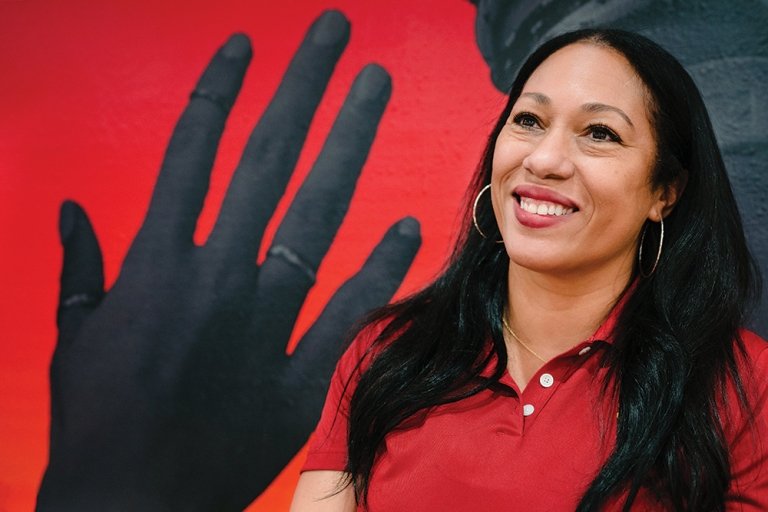
When an opening to lead the branch in Crenshaw came up, she was approached to take on the position. At first, she resisted. “I was like, what? That’s not even a promotion,” she recalls with a laugh. But she found something was pulling her back to the area where she spent intermittent periods of her youth.
Shortly after she accepted the position and was heading to work, she found herself taking a few back roads. Suddenly, she realized that a location near her new workplace was also a place where she experienced great trauma as a child. At that point, she knew that her new role was more than just a job: It was a calling. It felt like she was coming home, not only to face this trauma, but also to make this place where she experienced hardship better for today’s youth.
“I knew it was imperative to set the systems in place for little girls like me who live in this community to succeed. It is an overwhelming feeling, the way Things have fallen into place,” Ramsay-Stamps says.
“It’s a tale of two communities here—some of the wealthiest individuals in L.A. live in Baldwin Hills, View Park and Windsor Hills, right next to the poorest communities in the city,” she says. “There’s a lot of opportunity to be innovative and unique, and garner resources to get the work done. Crenshaw is in the midst of a cultural rebirth and has a long legacy and ties to athletes, artists and entertainers. The approach with my team is to elevate and bridge those assets of creativity and sports to educational, technological and environmental resources that will foster the development of the whole child in L.A,” Ramsay-Stamps says.
A chance to reimagine
Crenshaw is in South Los Angeles, about 5 miles from USC’s University Park campus. The neighborhood has a storied history and has long been a hub for Black culture in Los Angeles. But before the 1948 U.S. Supreme Court Ruling that struck down covenants that prevented non-White residents from living in certain parts of L.A., the neighborhood’s residents were mostly White and middle class. After 1948, the neighborhood became a destination for Japanese Americans as well as Black families. However, the drug epidemic of the 1980s, along with the subsequent “War on Drugs” and the L.A. riots of the early 1990s, took their toll on the community, as crime spiked, families left and businesses closed. In the past 20 years, the demographics of the neighborhood have also shifted, as Latinos have moved in. However, Crenshaw has remained a hotbed for arts and culture and Black-owned businesses.
The Crenshaw Family YMCA opened in 1952 at the intersection of Santa Rosalia Drive and Marlton Avenue, just across from the Baldwin Hills Crenshaw mall. When Ramsay- Stamps took the job as executive director, her colleagues and superiors knew she didn’t have the typical “swim and gym” background of most branch leaders. Instead, her approach would center the YMCA as a hub for the community, somewhere residents would come for everything from job fairs to after-school programming for kids.
“I’m looking to explore the best models on the planet Earth for communities of color, like Crenshaw.” —Veda Ramsay-Stamps MPA ’18, executive director of the Crenshaw Family YMCA
Athletics would still be a focus, but as part of an assortment of offerings. When the COVID-19 pandemic hit, the pivot to other services came quickly. Ramsay-Stamps, with her background in community and policy work, was well-positioned to transform the Crenshaw Family Y into a nucleus for the community’s needs. The Y became a location for food distribution in the early days of the pandemic, with lines of residents wrapping around the block to pick up food.
Ramsay-Stamps also saw that not all the children in the neighborhood had access to free, reliable internet and computers at home to attend remote school. So, she got to work and brought in a new partner, Salesforce, to address these digital challenges. The San Francisco-based software company outfitted the YMCA with high-speed Wi-Fi and provided the kids with Chromebooks. Some Salesforce employees even volunteered to tutor the kids for several months.
As Ramsay-Stamps was reimagining—by necessity—the role of the YMCA in the community, the very space of the building was also being reimagined. The redesign, which Ramsay-Stamps refers to as “Phase 1,” involved a collaboration between the Jordan Brand and NBA star Russell Westbrook’s Why Not? Foundation.
Westbrook grew up in Crenshaw and played basketball at the Crenshaw YMCA. During the renovation, the basketball court was transformed with a floor-to-ceiling mural on one wall by L.A. artist Chris Burnett and beautiful wood flooring. The Jr. Clippers basketball program remains a huge draw, and on any given night, the thump of balls and voices of children and teens can be heard throughout the gym. Family members often linger, watching the kids from the bleachers and speaking with the other families.
For Otis Noble III, the basketball program provides a chance to connect his son, Nico, to the Black community. Noble, who works at UCLA as an assistant director for community engagement, enrolled his son in a private school, but the Jr. Clippers program is giving Nico an opportunity to build relationships with more kids who look like himself. Noble praises Ramsay-Stamps’ efforts to unite the community. She’s “doing it for the kids,” he says, and she’s able to do it “because of who she is.”
Many other spaces at the YMCA were also renovated during Phase 1; the building was outfitted with a new computer lab and a Why Not? Room, an area where kids can lounge and watch movies or attend presentations from the creative and inspiring minds that Ramsay-Stamps and community partners bring in to speak. Recent speakers have included technologist Iddris Sandu and skateboarder and Stanford graduate Tobias McIntosh, who founded Crenshaw Skate Membership at age 14.
Phase 2 renovations include an emphasis on “biophilic design”—that is, design meant to enhance occupants’ connectivity to the natural environment. It’s a special cause for Ramsay-Stamps, and the focus of her dissertation. Residents of Crenshaw do not enjoy the same access to greenspaces as their wealthier White neighbors. In areas with higher populations of White residents have around 32 acres of parkland per 1,000 residents, compared with less than 2 acres per 1,000 residents in communities that are majority Black and Latino.
At the Crenshaw Family YMCA, plans are underway to create an urban food and digital garden, an indoor/outdoor Sports Performance Wellness Center and Learning Lab through a partnership with the USC Office of the Provost and USC Iovine and Young Academy. While the YMCA had a garden in the past, its upkeep proved difficult. Ramsay-Stamps, through the collaboration, is considering several methods of sustainability, from robotics to automated vertical gardens that accentuate the current Crenshaw Family YMCA programming. She sees the garden as an opportunity not only for residents to participate in the growing of fruits and vegetables but also for the kids to witness and be a part of innovative uses of technology, with USC students guiding them. “We’re delighted to join the Crenshaw Y in reimagining an urban garden that fosters healthy behaviors, creativity, as well as individual and collective growth,” said Trent Jones, Academy faculty lead for the project. “With the development of this garden, we hope it creates more green space through community collaboration.”
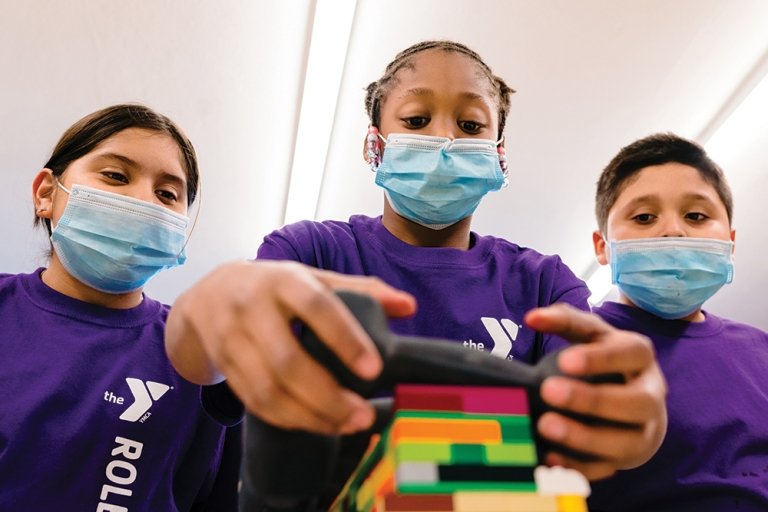
Education as the North Star
For Ramsay-Stamps, education is central. It’s what led her to USC Rossier. She’s witnessed first-hand the challenge of attending schools identified as the nation’s most underperforming, and her time working in local government reinforced her belief that education—and creating equal access to quality education—is one of the most valuable tools. After all, Ramsay-Stamps is living proof of the benefits of quality education coupled with a supportive environment.
“Education is where the biggest problems are for our community. That’s where the challenges live,” says Ramsay-Stamps. Innovation, coordination and resources are particularly lacking in education, she says. She aims to lean on her private-sector experience and public policymaking perspective to help tackle some of the deep-rooted educational issues in communities like Crenshaw. The issues are ones she’s come to understand more intimately through her studies in USC Rossier’s Global EdD program.
The travel component of the program was especially attractive to Ramsay-Stamps. While she is currently focused on local, on-the-ground community work, she’s always had the ability to oscillate easily between the details and the bigger picture. The program has given her a chance to study educational systems around the world. “I’m looking to explore the best models on the planet Earth for communities of color, like Crenshaw,” she says. “I know I’m not going to be the one to change everything, but I’m hoping that I can add my little nuggets in my subject matter.”
“Community means providing support systems to those who lack those supports within their family structure. It means creating an atmosphere where one feels loved, appreciated and valued.” —Veda Ramsay-Stamps MPA ’18
Ramsay-Stamps and USC Rossier hope to expand the facility’s educational offerings by serving as a Learning Lab, hosting a speaker series and creating additional pipelines for more low-income students of color.
To collectively lift up children who face the hardships Ramsay-Stamps experienced as a child, “it takes a community effort,” she says—“the private sector, educational institutions, community-based organizations all actively coordinating together to correct those challenges.”
Ramsay-Stamps thinks back to her days in New Orleans. “Even though I had struggles, the community vibe of Pontchartrain Park is the epitome of what I want other children to feel: to know your teachers care about you, even if they’re tough with you, neighbors who are watching out for you, and a walkable environment, one you feel safe in,” she says.
“Community means providing support systems to those who lack those supports within their family structure,” she adds. “It means creating an atmosphere where one feels loved, appreciated and valued. Community—even when I hear the word, I think happiness.”

